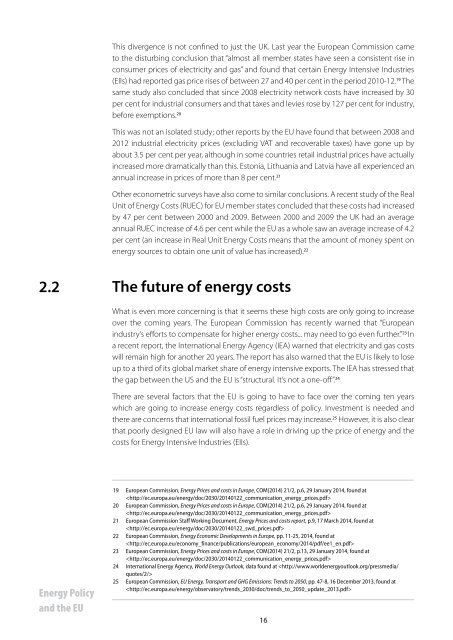BFBEnergyPaper
BFBEnergyPaper
BFBEnergyPaper
Create successful ePaper yourself
Turn your PDF publications into a flip-book with our unique Google optimized e-Paper software.
This divergence is not confined to just the UK. Last year the European Commission cameto the disturbing conclusion that “almost all member states have seen a consistent rise inconsumer prices of electricity and gas” and found that certain Energy Intensive Industries(EIIs) had reported gas price rises of between 27 and 40 per cent in the period 2010-12. 19 Thesame study also concluded that since 2008 electricity network costs have increased by 30per cent for industrial consumers and that taxes and levies rose by 127 per cent for industry,before exemptions. 20This was not an isolated study; other reports by the EU have found that between 2008 and2012 industrial electricity prices (excluding VAT and recoverable taxes) have gone up byabout 3.5 per cent per year, although in some countries retail industrial prices have actuallyincreased more dramatically than this. Estonia, Lithuania and Latvia have all experienced anannual increase in prices of more than 8 per cent. 21Other econometric surveys have also come to similar conclusions. A recent study of the RealUnit of Energy Costs (RUEC) for EU member states concluded that these costs had increasedby 47 per cent between 2000 and 2009. Between 2000 and 2009 the UK had an averageannual RUEC increase of 4.6 per cent while the EU as a whole saw an average increase of 4.2per cent (an increase in Real Unit Energy Costs means that the amount of money spent onenergy sources to obtain one unit of value has increased). 222.2The future of energy costsWhat is even more concerning is that it seems these high costs are only going to increaseover the coming years. The European Commission has recently warned that “Europeanindustry’s efforts to compensate for higher energy costs... may need to go even further.” 23 Ina recent report, the International Energy Agency (IEA) warned that electricity and gas costswill remain high for another 20 years. The report has also warned that the EU is likely to loseup to a third of its global market share of energy intensive exports. The IEA has stressed thatthe gap between the US and the EU is “structural. It’s not a one-off”. 24There are several factors that the EU is going to have to face over the coming ten yearswhich are going to increase energy costs regardless of policy. Investment is needed andthere are concerns that international fossil fuel prices may increase. 25 However, it is also clearthat poorly designed EU law will also have a role in driving up the price of energy and thecosts for Energy Intensive Industries (EIIs).Energy Policyand the EU19 European Commission, Energy Prices and costs in Europe, COM(2014) 21/2, p.6, 29 January 2014, found at20 European Commission, Energy Prices and costs in Europe, COM(2014) 21/2, p.6, 29 January 2014, found at21 European Commission Staff Working Document, Energy Prices and costs report, p.9, 17 March 2014, found at22 European Commission, Energy Economic Developments in Europe, pp. 11-25, 2014, found at23 European Commission, Energy Prices and costs in Europe, COM(2014) 21/2, p.13, 29 January 2014, found at24 International Energy Agency, World Energy Outlook, data found at 25 European Commission, EU Energy, Transport and GHG Emissions: Trends to 2050, pp. 47-8, 16 December 2013, found at16


